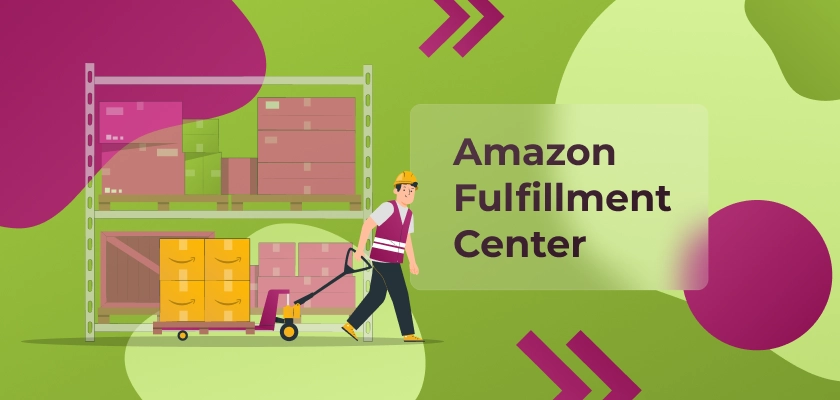Table of Contents
Amazon has transformed the eCommerce landscape through its highly efficient fulfillment network, enabling sellers to swiftly reach millions of customers globally. Central to this expansive network is the Amazon Fulfillment Center (AFC), a bustling nexus aimed at storing, picking, packing, and shipping items with utmost efficiency. In this detailed guide, we will explore the workings of these fulfillment centers, their advantages for sellers and customers alike, and the crucial role technology and automation play within them.
What is Amazon Fulfillment Center?
An Amazon Fulfillment Center stands as the zenith of contemporary logistics and warehousing, showcasing the meticulous organization, management, and distribution of Amazon’s extensive inventory. These centers, which are the embodiment of cutting-edge technology and thoughtful design, are strategically placed around the world to ensure rapid delivery times and the utmost in efficient inventory control. Within these vast warehouses, products are methodically received from suppliers, securely stored until sold, and then carefully packaged and shipped to customers. Spanning more than 175 fulfillment centers globally, with the number steadily increasing, Amazon’s extensive network is constantly evolving and expanding to satisfy growing consumer demand. This worldwide infrastructure not only makes the delivery process more efficient but also significantly enhances Amazon’s ability to offer a wide array of products, thereby maintaining its leadership in customer satisfaction and logistical superiority.

Inventory Management
At the heart of the AFC’s remarkable efficiency lies its state-of-the-art inventory management system. This meticulously designed system meticulously tracks every single item from the moment it arrives at the facility, through its storage phase, and finally, to the point when it’s carefully shipped out to customers. By doing so, the system plays a crucial role in enabling sellers to maintain perfect inventory levels. It achieves this by offering real-time insights into crucial metrics such as current stock levels, the velocity at which products are selling, and impending replenishment needs. This advanced system not only significantly benefits sellers by reducing overstock or stockout scenarios but also guarantees that customers receive their orders swiftly and dependably.
Moreover, for businesses striving to further optimize their presence and sales on Amazon, incorporating tools like SageMailer into their strategy can prove to be a game-changer. SageMailer excels by providing seamless email automation services, which simplifies the process for sellers to boost their organic feedback and product review counts. This is done while ensuring full compliance with all of Amazon’s stringent policies. Utilizing SageMailer not only enhances seller performance by improving their reputation and visibility on the platform but also contributes to a better overall customer experience through improved communication and satisfaction.
How does the Amazon Fulfillment Center Work?
Discover the cutting-edge operations behind an Amazon Fulfillment Center (AFC), showcasing the ultimate in logistics efficiency and innovation:
- Receiving: Products from sellers arrive at the AFC and are subjected to a thorough quality and accuracy check. This ensures every product meets Amazon’s high standards before being offered to customers.
- Storage: After inspection, products are carefully organized in the vast storage areas of the fulfillment center. The storage system is designed for maximum efficiency, allowing for quick retrieval. Products are sorted by size, weight, and category, making them easily accessible for the next steps.
- Ordering: When a customer places an order, the system springs into action. Using advanced algorithms, it quickly locates the item. A picker is then directed to the exact location, streamlining the retrieval process.
- Packing: Items are then expertly packed, selecting the right box or packing material to protect the item during shipping. The package is labeled with all necessary shipping details, including a barcode to indicate it’s ready to be sent out.
- Shipping: The final step is dispatching the package to the customer. Orders are sorted by destination and handed off to carriers. The logistics system intelligently selects the best carrier based on delivery speed and cost, ensuring efficient delivery.
Throughout these operations, Amazon uses sophisticated systems and algorithms to enhance the flow of items. These technologies analyze data to choose the most efficient route for each item, factoring in customer location, delivery preferences, and the fulfillment center’s capacity. This high level of optimization guarantees that Amazon delivers orders with remarkable speed and accuracy, reinforcing its position as a leader in global e-commerce logistics.
Fulfillment
At the core of Amazon Fulfillment Centers (AFCs) resides the comprehensive fulfillment operation, which extends across a multitude of activities from the initial receipt of inventory within the warehouse to the meticulous packing and dispatching of orders to customers. This elaborate process includes inventory management, order processing, and the detailed tasks of picking, packing, and shipping. Amazon’s fulfillment strategy, distinguished by its exceptional efficiency, is designed to minimize delays, thereby ensuring prompt delivery of customer purchases. This dedication to timeliness and reliability plays a crucial role in enhancing customer satisfaction and fostering loyalty among consumers, which are key factors in Amazon’s sustained success in the highly competitive e-commerce industry.
Benefits for Sellers and Customers
For Sellers: Leveraging Amazon’s Fulfillment Centers provides a notable advantage by enabling sellers to utilize Amazon Prime’s expedited shipping options, markedly increasing the attractiveness of their products to a wider audience seeking prompt delivery. This strategy not only augments customer satisfaction but also affords sellers a competitive edge in the market. Furthermore, by entrusting inventory and logistics management to Amazon’s advanced system, sellers can divest themselves of the burdensome responsibilities associated with storage and shipment, thus freeing up more time and resources for strategic planning and business expansion.
For Customers: The Amazon Fulfillment Center (AFC) system is engineered to ensure that customers enjoy access to an extensive selection of products with swift shipping options, simplifying the process of finding and receiving items expeditiously. This system plays a crucial role in improving the overall shopping experience on Amazon, offering a degree of convenience and dependability that customers expect from the online retail leader. Additionally, the straightforward returns policy further elevates customer satisfaction by creating a risk-free shopping milieu. Amazon’s dedication to customer service fortifies its leadership position in the online retail sector, establishing it as the preferred platform for consumers in search of a streamlined shopping experience.
Conclusion
Amazon Fulfillment Centers play a crucial role in the eCommerce giant’s success, acting as the backbone that ensures speed, efficiency, and scalability in operations. These centers are pivotal for sellers on Amazon, as leveraging the state-of-the-art capabilities of these facilities can dramatically enhance their business success. By using tools like SageMailer, sellers can further maximize their operations, making their products more visible and appealing to a broader audience. This symbiotic relationship not only boosts the sellers’ success but also enhances the overall customer experience. Customers, on the other hand, enjoy a vast selection of products and the convenience of rapid delivery, which solidifies Amazon’s position as a top choice for online shopping. The seamless integration of advanced logistics and customer-focused technologies make shopping on Amazon a delightful and satisfying experience, fostering a loyal customer base that keeps coming back for more.


